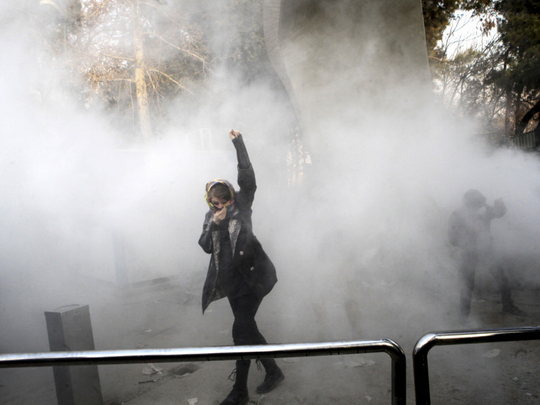
With Iran experiencing its largest, most widespread protests in years, thoughts in the White House will inevitably turn to Iran’s 2009 “Green Movement”, sparked by what was widely considered to be the rigging of presidential elections by Iranian authorities that year. The then United States president Barack Obama’s administration, unsure of how to help the protesters and reluctant to scuttle its nascent engagement with Tehran, responded to the demonstrations with diffidence, prompting criticism from Left and Right alike.
It should thus come as little surprise that US President Donald Trump — fresh off repudiating Obama’s nuclear deal with Iran — has taken the opposite tack and thrown his weight behind the protesters. But the Trump administration faces the conundrum that has long stymied US officials seeking to support dissidents abroad: What precisely can the US do, beyond issuing statements? After all, a loud statement unsupported by action is unlikely to have more impact than one delivered sotto voce.
Like so many protests around the world, the current demonstrations in Iran appear to have begun with bread-and-butter concerns. Iranians expected their lives to improve after the 2015 nuclear deal, and although Iran has experienced economic growth overall, Iranians still face rising prices and high unemployment. Economics and politics are inextricably linked, so it is not surprising that protesters have also decried corruption and expenditures on foreign conflicts in Syria and elsewhere at a time when domestic needs seem so great.
Given its own concerns about Iran’s regional policies, Washington has a stake in this debate. Yet many, including many Iranians, will advise the US and other foreign governments to stay quiet on the protests for fear of tarnishing them by association with outside powers. But the regime will seek to paint protesters as foreign agents regardless of the reality. The best way to counter this is not to remain silent but to ensure that US statements of support are broadly multilateral and are backed with more practical steps.
The US and its allies should, through public statements, private messages, United Nations resolutions and whatever other vehicles are available, clearly express their support for Iranians’ right to protest. They should also warn authorities in Iran against any violent suppression of the demonstrations, whether such violence takes place on the streets or — as occurred after the 2009 protests — later on in homes and prisons, out of the public eye. Both the regime and demonstrators should be made constantly aware that the world’s attention is fixed on them.
If the regime resorts to violence anyway, the international response should focus on diplomatic isolation. European and Asian states should reduce their diplomatic ties with Iran and downgrade Iran’s participation in international forums. Sanctions may also have a role, but they should be carefully targeted against those responsible for any crackdown — as well as those outside Iran who facilitate their actions — so as not to harm the Iranians whom the measures aim to support.
Such warnings alone are unlikely to deter Iranian authorities, who have proved both savvy and ruthless in employing their security apparatus against dissidents. Thus another focus of the international community’s response should be helping Iranians elude that apparatus and exercise the basic rights that it seeks to deny them.
In 2009, State Department official Jared Cohen, without authorisation, implored Twitter to forgo a shutdown for scheduled maintenance that happened to coincide with the protests in Iran. Present-day officials, journalists and tech execs should take their cue from Cohen but go further, seeking to provide platforms outside Iran for dissidents to speak out and supply accurate information to those inside Iran about both the protests and the costs of the regime’s policies, along with the technical tools Iranians need to evade censorship and surveillance.
Finally, the Trump administration should consider how its broader Iran policy affects what happens inside Iran. This is not to say that the US should be in the business of currying favour with the regime’s “moderates” — Washington has engaged in such efforts over the decades, largely fruitlessly. Instead, the US can sharpen the choices facing Iran as a whole — and strengthen the arguments of pragmatists arguing for a change in policy — by raising the costs of Iranian regional adventurism and nuclear pursuits while keeping the door open to diplomacy should Iran wish to pursue its interests peacefully.
Western officials should avoid projecting their own hopes onto the Iranian protesters, whose grievances appear varied and are not necessarily aligned with the West’s own complaints about the regime. Western officials should also keep their expectations of the protests in check. They could gather steam, or they could subside. The sign of a successful policy response will be its ability to survive either eventuality, based on the premise that an Iran that is more responsive to the needs of its people will be less dangerous to its region and to the US.
— Washington Post
Michael Singh is managing director and senior fellow at the Washington Institute for Near East Policy.








